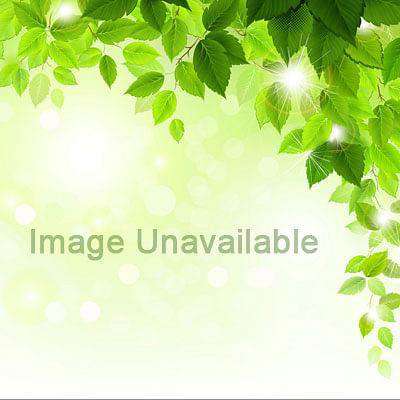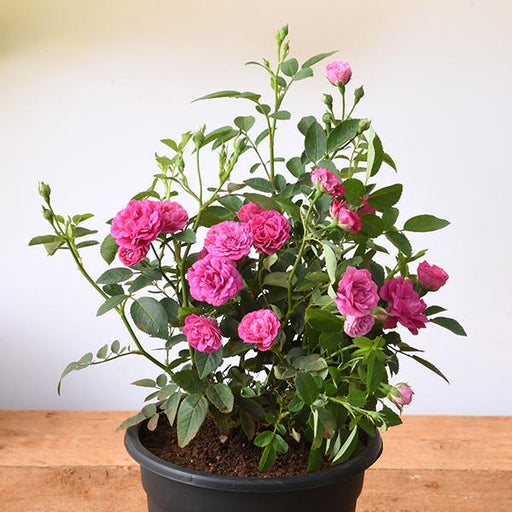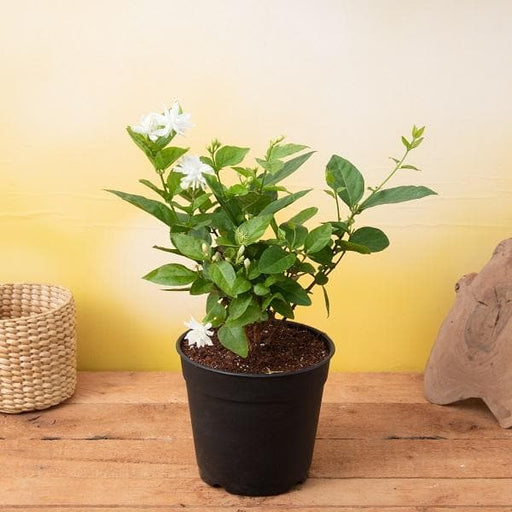
Caesalpinia echinata - Plant
(MRP Inclusive of all taxes)
- Shipping ₹79 for entire order
- Dispatch in 7 days
- Country of origin: India

(MRP Inclusive of all taxes)
 Save 29%
Save 29%
Air Purifier Money Plant with Pot The Air Purifier Money Plant, also known as Pothos or Epipremnum aureum, is a stunning indoor plant that...
View full details
 Save up to 15%
Save up to 15%
Peace Lily, Spathiphyllum - Plant The Peace Lily, scientifically known as Spathiphyllum, is a stunning houseplant celebrated for its elegant white...
View full details
 Save 25%
Save 25%
Jasminum sambac, Mogra, Arabian Jasmine - Plant Jasminum sambac, commonly known as Mogra or Arabian Jasmine, is a fragrant flowering plant...
View full details
 Save 18%
Save 18%
Combo Constituents Includes the Parijat Tree (Night-Flowering Jasmine), a culturally significant plant with fragrant flowers. Description The Pari...
View full details
 Save 25%
Save 25%
Miniature Rose, Button Rose (Any Color) - Plant The Miniature Rose, also known as the Button Rose, is a charming and compact flowering plant that ...
View full details Save 25%
Save 25%
Damascus Rose, Scented Rose (Any Color) - Plant The Damascus Rose, also known as Rosa damascena, is a timeless symbol of beauty and romanc...
View full details
 Save 17%
Save 17%
Beautiful Fragrant Mogra, Arabian Jasmine Plant with Pot The Beautiful Fragrant Mogra, also known as Arabian Jasmine (Jasminum sambac), is...
View full details Save 15%
Save 15%
Pack of Vermicompost and Neem Cake for House Plants Transform your indoor garden with our premium Pack of Vermicompost and Neem Cake, spec...
View full details
Pack of Plant Growth and Flower Boosters Unlock the full potential of your garden with our Pack of Plant Growth and Flower Boosters! This ...
View full details Save 38%
Save 38%
Combo of Jeevamrut and Neem Raksha for Easy Growth and Protection of Houseplants Transform your indoor garden with our exclusive combo of ...
View full details Save 22%
Save 22%
Plant Nutrients Kit (Pack of 16) for a Healthy Garden Transform your garden into a lush paradise with our Plant Nutrients Kit, featuring 1...
View full details Save 16%
Save 16%
Combo of Top Plant Fertilizers Elevate your gardening game with our exclusive Combo of Top Plant Fertilizers, featuring two bags of premiu...
View full details Save 24%
Save 24%
Pack of 4 Additives to Make Soil Healthy and Nutrient Rich Transform your garden into a thriving ecosystem with our Pack of 4 Additives de...
View full details Save 30%
Save 30%
Transform your gardening experience with our premium Combo of Perlite and Vermiculite. This unique blend is designed to enhance soil aeration and ...
View full details Save 27%
Save 27%
Combo of 2 Vermicompost and Cocopeat - Enrich Your Soil Naturally! Transform your garden into a thriving ecosystem with our Combo of 2 Ver...
View full details
 Save 35%
Save 35%
Best 6 Plants for Perfect Indoor Garden Transform your living space into a lush oasis with our curated collection of the Best 6 Plants for a...
View full details
 Save up to 50%
Save up to 50%
Mini Succulent Garden Pack Transform your space with our Mini Succulent Garden Pack, featuring a delightful collection of 4 any variety beautiful s...
View full details
 Save 30%
Save 30%
5 Best Fragrant Plants Transform your garden or indoor space into a fragrant paradise with our curated selection of the 5 Best Fragrant Plants. Th...
View full details
 Save 24%
Save 24%
Set of 2 Bonsai Looking Grafted Adeniums Transform your indoor or outdoor space with our exquisite Set of 2 Bonsai Looking Grafted Adenium...
View full details Save 45%
Save 45%
Top 4 Die Hard Succulents Pack Transform your indoor or outdoor space with our Top 4 Die Hard Succulents Pack, featuring a curated selecti...
View full details
 Save 30%
Save 30%
5 Best Indoor Plants Pack Transform your living space into a lush oasis with our '5 Best Indoor Plants Pack.' This carefully curated collection fe...
View full details
 Save 25%
Save 25%
Set of 4 Evergreen Air Purifier Plant Pack Transform your indoor space into a lush, green oasis with our Set of 4 Evergreen Air Purifier Pla...
View full details| SrNo | Item Name |
|---|---|
| 1 | Caesalpinia echinata - Plant |
Caesalpinia echinata, commonly known as Brazilian Rosewood, is a stunning tropical tree native to Brazil. Renowned for its rich, dark wood and vibrant yellow flowers, this plant is not only a visual delight but also holds significant ecological and economic importance. The wood is highly sought after for its use in fine furniture and musical instruments, making it a valuable species in both horticulture and industry.
What makes Caesalpinia echinata truly special is its unique combination of beauty and utility. The tree can grow up to 15 meters tall and features a dense canopy that provides excellent shade. Its striking flowers attract pollinators, contributing to local biodiversity. Additionally, the plant is a symbol of Brazil's rich natural heritage and has been historically significant in the production of high-quality rosewood.
One of the standout features of Caesalpinia echinata is its ability to thrive in poor soil conditions, making it an excellent choice for reforestation projects. Its deep root system helps prevent soil erosion, while its foliage provides habitat for various wildlife species. This plant not only enhances the landscape but also plays a crucial role in maintaining ecological balance.
Caesalpinia echinata plays a vital role in its ecosystem by providing habitat for various species and improving soil quality. Its ability to fix nitrogen in the soil enhances fertility, making it beneficial for surrounding plants. By planting this species, you contribute to biodiversity and help combat deforestation.
If you think caring for a plant is as easy as watering it and singing a little tune, think again! Caesalpinia echinata, also known as Brazilwood, requires a bit more finesse. This diva of the plant world loves well-drained soil and plenty of sunlight. It’s like the sunbather of the botanical realm, soaking up rays while you’re stuck inside. Just remember, overwatering is a no-no; it’s not a fan of soggy feet. So, give it a little love, a sprinkle of water, and watch it thrive like the star it is!
Why should you invite this plant into your garden? Well, let’s just say it’s the life of the party! Not only does Caesalpinia echinata produce stunning flowers that can make any garden look like a tropical paradise, but it also has medicinal properties. Historically, it’s been used for everything from dyeing fabrics to treating ailments. Talk about a multitasker! Plus, it attracts pollinators like bees and butterflies, making your garden the hottest spot in town.
Ready to spread the love? Propagating Caesalpinia echinata is like playing plant matchmaker. You can do it through seeds or cuttings, but seeds are the way to go if you want to see some real action. Soak those seeds overnight, plant them in well-draining soil, and watch as they sprout like eager party guests. Just remember, patience is key; good things come to those who wait, especially when it comes to plants!
This plant isn’t just a pretty face; it’s got skills! Caesalpinia echinata has been used for centuries in woodworking, thanks to its dense, durable timber. It’s like the lumberjack of the plant world, perfect for making furniture and musical instruments. Plus, its vibrant flowers can be used in landscaping to add a splash of color. So, whether you’re looking to build a chair or just want to impress your neighbors, this plant has got you covered!
If you’re wondering where this beauty likes to hang out, look no further than the tropical and subtropical regions of South America. Caesalpinia echinata thrives in warm climates, basking in the sun like a beachgoer on vacation. It prefers well-drained soils and can often be found in dry forests. So, if you’re planning a trip to Brazil, keep an eye out for this stunning tree; it’s the local celebrity of the plant kingdom!
If you’re looking for a fast-growing tree, Caesalpinia echinata might just be your new best friend. This plant can grow up to 30 feet tall in the right conditions, making it the overachiever of the botanical world. With a growth rate that can leave other trees in the dust, it’s perfect for those who want a quick transformation in their garden. Just remember, with great height comes great responsibility—make sure you have enough space for this towering beauty!
Every plant has its enemies, and Caesalpinia echinata is no exception. While it’s generally resilient, it can attract pests like aphids and scale insects. Think of them as the uninvited guests at your plant’s party. But fear not! A little neem oil or insecticidal soap can send those pests packing. Keep an eye out, and your plant will continue to shine like the star it is, free from pesky intruders.
If you want your Caesalpinia echinata to thrive, you need to roll out the red carpet—aka, the right soil! This plant prefers sandy or loamy soil that drains well. It’s like a diva that refuses to step into muddy shoes. So, make sure to mix in some organic matter to keep it happy. With the right soil, your plant will flourish, and you’ll be the proud parent of a botanical superstar!
Get ready for a floral extravaganza! Caesalpinia echinata typically blooms in the spring and summer, showcasing vibrant yellow and orange flowers that can brighten up any dull day. It’s like a fireworks show, but for your garden! These blooms not only attract pollinators but also add a splash of color that can make your neighbors green with envy. So, mark your calendar and prepare for the floral fiesta!
Looking to jazz up your outdoor space? Caesalpinia echinata is the perfect candidate for landscaping projects. With its stunning flowers and impressive height, it can serve as a focal point or a lovely backdrop. Imagine hosting a garden party with this beauty as your centerpiece—your guests will be in awe! Plus, it’s drought-tolerant, making it a low-maintenance option for those who want a gorgeous garden without the hassle.
This plant isn’t just a pretty face; it has a history steeped in traditional medicine. Caesalpinia echinata has been used to treat various ailments, from fevers to inflammation. It’s like having a mini pharmacy right in your garden! While you might not want to replace your doctor with a tree, having this plant around can certainly add a touch of natural healing to your life. Just remember, consult a professional before trying any home remedies!
Caesalpinia echinata, also known as Brazilwood, is a tropical tree famous for its vibrant red heartwood. This botanical superstar is not just a pretty face; it’s a key player in the ecosystem, providing habitat and food for various wildlife. Plus, it’s a favorite among woodworkers for its stunning grain. Talk about a multitasker!
This tropical diva thrives in the coastal regions of Brazil, particularly in the Atlantic Forest. It loves warm, sunny spots and well-drained soil, making it the perfect plant for those who enjoy a little sunshine in their lives. Just remember, it’s not a fan of frost—so keep it cozy!
Caesalpinia echinata can reach heights of up to 15-20 meters (about 50-65 feet). That’s taller than your average giraffe! With its impressive stature, it’s sure to make a statement in any garden. Just be prepared for some serious pruning if you want to keep it in check!
Beyond its stunning appearance, Caesalpinia echinata is prized for its dense, reddish-brown wood, often used in furniture and musical instruments. It’s also a traditional source of dye, giving fabrics a rich, warm hue. Who knew this tree could be such a trendsetter in both fashion and furniture
Yes, unfortunately, Caesalpinia echinata is considered endangered due to habitat loss and overexploitation. It’s like the celebrity of the plant world—everyone wants a piece! Conservation efforts are underway, so let’s give this beauty a fighting chance to thrive in its natural habitat.
Propagation is as easy as pie! You can start by planting seeds or taking cuttings. Just make sure to soak those seeds overnight to soften their hard exterior. With a little patience and care, you’ll have your very own Brazilwood tree ready to strut its stuff in no time!
Caesalpinia echinata prefers well-drained, sandy or loamy soil. Think of it as a plant that enjoys a good spa day—no soggy feet allowed! A little organic matter mixed in can help it thrive, but don’t go overboard. It’s all about balance, darling!
Watering is a delicate dance! During the growing season, keep the soil moist but not soggy. Once established, it’s quite drought-tolerant, so you can ease up on the watering. Just remember, too much love can drown this beauty—so let it breathe!
Like any diva, Caesalpinia echinata can attract a few unwanted guests, such as aphids and scale insects. But fear not! A little neem oil or insecticidal soap can send those pests packing. Keep an eye out, and your tree will remain the belle of the botanical ball!
While it prefers the great outdoors, you can grow Caesalpinia echinata indoors if you have a sunny spot and enough space. Just remember, it’s a tree, not a houseplant! Give it room to grow, and it might just reward you with its stunning foliage and vibrant blooms.
Caesalpinia echinata typically blooms in the summer, showcasing its beautiful yellow and red flowers. These blossoms are like nature’s confetti, attracting pollinators and adding a splash of color to your garden. So, get ready to celebrate the summer with this floral fiesta!